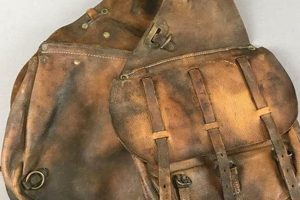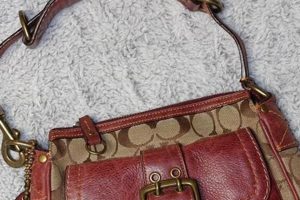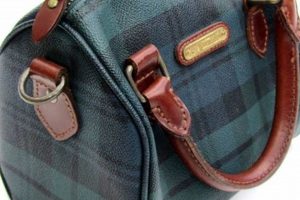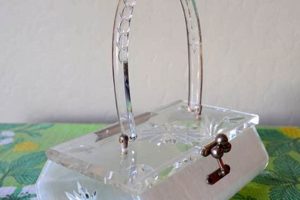A doctor’s bag, particularly one from a past era, embodies a specific design aesthetic and functional purpose. These bags, typically crafted from leather or durable textiles, were essential tools for physicians making house calls. They provided a means to transport medical instruments, medications, and diagnostic equipment to patients’ homes, ensuring comprehensive care could be delivered outside of a clinical setting. An example would be a leather Gladstone bag, circa 1940, complete with internal compartments designed to hold vials and syringes.
The significance of these historical items lies in their representation of medical history and craftsmanship. They offer a tangible connection to past practices and provide insight into the evolution of healthcare delivery. Moreover, they often represent a higher standard of material quality and construction than contemporary equivalents, resulting in lasting durability. Their appeal extends beyond medical professionals, resonating with collectors and enthusiasts who appreciate their unique design and historical context.
The subsequent sections will delve into the various styles of these bags, their characteristic features, factors influencing their value, and considerations for their preservation and restoration. This exploration aims to provide a comprehensive understanding of these enduring relics of medical history.
The acquisition and preservation of an antique medical carrier requires careful consideration. The following tips offer guidance for those interested in owning and maintaining these artifacts.
Tip 1: Assess Condition Diligently: Prior to purchase, examine the item thoroughly for signs of wear, damage, or repairs. Note any tears in the leather, compromised stitching, or evidence of mold or mildew. A detailed inspection will inform restoration needs and impact valuation.
Tip 2: Verify Authenticity: Research the maker and era of the carrier. Consult historical records, medical catalogs, and expert appraisers to confirm its provenance. Counterfeit or misrepresented items exist within the market.
Tip 3: Understand Material Sensitivity: Leather, commonly used in the construction of these bags, is susceptible to environmental factors. Control humidity and temperature during storage to prevent cracking, discoloration, and fungal growth. Avoid direct sunlight.
Tip 4: Employ Gentle Cleaning Methods: When cleaning the exterior, use a soft, damp cloth and specialized leather cleaner. Avoid harsh chemicals or abrasive materials that can damage the surface. Interior cleaning should be executed with caution to prevent further deterioration of linings and compartments.
Tip 5: Secure Proper Storage: Store the carrier in a dust-free environment, preferably within a breathable bag or container. Stuffing the bag with acid-free tissue paper helps maintain its shape and prevents collapsing.
Tip 6: Evaluate Restoration Needs: Damaged stitching, weakened handles, or deteriorated interiors may necessitate professional restoration. Seek qualified conservators with experience in handling antique leather goods to ensure preservation of the item’s historical integrity.
The careful application of these guidelines can help prospective owners navigate the intricacies of acquiring and preserving an antique medical carrier, ensuring its longevity and historical significance for future generations.
The subsequent section will explore the potential for these items as investments and their role in historical collections.
1. Material Durability
Material durability is a foundational element in determining the value and longevity of a vintage doctor’s bag. The choice of materials, predominantly leather, and the construction methods employed directly influenced the bag’s ability to withstand the demanding conditions of regular use. Bags crafted from high-quality, thick-gauge leather, meticulously stitched and reinforced at stress points, exhibited superior resistance to wear and tear. This inherent toughness ensured that the bag could reliably transport medical instruments and supplies, a critical requirement for physicians making house calls. The presence of such robust construction techniques in a vintage example signifies a commitment to quality and functionality, factors that significantly enhance its appeal to collectors and historians.
The long-term preservation of a doctor’s bag is inextricably linked to its initial material integrity. Bags constructed with inferior materials, such as thinly processed leather or weak stitching, are more susceptible to deterioration over time. Cracking, tearing, and the breakdown of seams are common issues encountered with such items. Conversely, bags exhibiting superior material durability often retain their structural integrity and aesthetic appeal for decades, even centuries. A well-preserved example provides invaluable insight into the medical practices and material culture of its era. For instance, a Gladstone-style bag from the early 20th century, crafted from vegetable-tanned leather and exhibiting minimal wear, offers a tangible connection to the professional lives of physicians during that period.
The emphasis on material durability in vintage doctor’s bags reflects the inherent need for reliability in medical practice. These bags were not mere accessories; they were essential tools that facilitated the delivery of healthcare in diverse environments. Consequently, the durability of the bag directly impacted the physician’s ability to provide timely and effective treatment. The study of material durability in these artifacts, therefore, offers a deeper understanding of the values and priorities of medical professionals throughout history and underscores the importance of selecting quality materials for enduring function and aesthetic value.
2. Design Evolution
The design evolution of the doctor’s bag is inextricably linked to advancements in medical practice, material science, and societal expectations. The earliest iterations were often simple pouches or satchels, prioritizing basic containment and portability. As medical knowledge and technology progressed, so did the complexity and specialization of the bag. Compartments were added to organize instruments and medications, and durable materials like leather became increasingly prevalent for protection and longevity. This progression reflects a growing emphasis on efficiency, hygiene, and the professional image of the physician. For example, the introduction of the Gladstone bag in the mid-19th century marked a significant shift, featuring a rigid frame and hinged opening that provided enhanced access and security compared to its predecessors. The evolution in design is a tangible reflection of the changing needs of the medical profession throughout history.
Further illustrating this progression is the development of specialized compartments within the bag. Early bags often featured a single, undifferentiated space, requiring physicians to rummage for needed items. Later designs incorporated loops, pockets, and dividers to keep instruments separated and readily accessible. The inclusion of vial holders and designated spaces for specific diagnostic tools, such as stethoscopes and blood pressure cuffs, directly correlated with the increasing sophistication of medical diagnosis and treatment. Moreover, the external aesthetics of the bag also evolved, reflecting prevailing social norms and expectations. From plain, utilitarian designs to more refined and stylish models, the doctor’s bag served as a symbol of professional authority and status, subtly influencing the doctor-patient relationship. The practical significance of understanding design evolution lies in its ability to provide insights into the historical context and functional requirements of medical practice across different eras.
In summary, the design evolution of the vintage doctor’s bag is a crucial lens through which to examine the history of medicine. It demonstrates a clear and direct correlation between advancements in medical knowledge, technological innovation, and the changing needs of the practicing physician. Recognizing these design adaptations offers valuable insights into the priorities and constraints faced by medical professionals throughout different periods. The challenge for collectors and historians lies in interpreting these design features within their historical context to gain a deeper appreciation of the bag’s functional and symbolic significance.
3. Medical Utility
The medical utility of a vintage doctor’s bag represents its primary function: facilitating the delivery of medical care outside of a clinical setting. This utility dictates its design, construction, and features, shaping its role as an essential tool for physicians throughout history. Examining this utility provides insight into past medical practices and technological constraints.
- Portability of Essential Instruments
The principal role of the bag was to enable physicians to transport necessary instruments and medications to patients’ homes. Examples include stethoscopes, syringes, bandages, and antiseptics. The bag’s design often incorporated organizational features to ensure the efficient retrieval of items during urgent situations. The size and weight of the bag had to be manageable for a single practitioner, influencing its practical application in diverse environments.
- Protection of Medical Supplies
The bag’s construction, frequently utilizing durable materials like leather, served to protect sensitive medical supplies from damage during transit. The contents needed to be shielded from environmental factors such as temperature fluctuations and physical impacts. A secure closure mechanism was essential to prevent spillage or contamination, maintaining the integrity of the supplies. This protective function directly impacted the effectiveness and safety of medical interventions.
- Facilitation of House Calls
The very existence of the doctor’s bag facilitated the practice of house calls, a common feature of medical care in previous eras. It allowed physicians to provide a range of diagnostic and therapeutic services in the patient’s residence, addressing immediate health concerns. The bag’s portability eliminated the necessity for patients to travel to a clinic, particularly beneficial for those with mobility issues or contagious illnesses. The decline in house calls has diminished the bag’s original utility, transforming it into a historical artifact.
- Organization and Accessibility
The internal design of the vintage doctor’s bag frequently incorporated compartments, dividers, and loops to organize medical instruments and medications. This ensured rapid access to necessary items, allowing physicians to respond efficiently to medical emergencies. The layout was often intuitive, enabling practitioners to locate tools quickly, even in suboptimal lighting conditions. The effectiveness of this organizational system directly correlated with the speed and accuracy of medical interventions.
The diverse facets of medical utility, embodied within the design and function of the vintage doctor’s bag, highlight its essential role in the history of healthcare. These bags provide tangible evidence of past medical practices, offering insights into the challenges and innovations that have shaped modern medicine. While their original utility has diminished, their historical significance remains, serving as a reminder of a time when medical care was delivered directly to the patient’s doorstep.
4. Historical Context
The significance of a vintage doctor’s bag is profoundly intertwined with its historical context. The bag’s design, materials, and contents reflect the medical practices, technological capabilities, and prevailing societal norms of its era. To understand its true value and meaning, one must situate it within the specific historical period in which it was used. For example, a doctor’s bag from the late 19th century, complete with instruments for antiseptic surgery, demonstrates the influence of Listerian principles on medical practice during that time. The bag itself becomes a tangible representation of the era’s medical advancements and concerns.
Consideration of historical context is vital for accurate authentication and valuation. A bag purportedly from the Civil War era, but containing materials or designs not yet available during that period, would be deemed inauthentic. Similarly, understanding the economic conditions of a particular time allows for a more nuanced assessment of the bag’s original cost and its owner’s social standing. Furthermore, the diseases prevalent during a specific period often dictate the contents of the bag. A bag from the early 20th century might contain specific treatments for common ailments like tuberculosis or influenza, reflecting the major health challenges of the time. The bag’s contents, therefore, serve as a historical record of the medical landscape.
In conclusion, the historical context is not merely a background element but an integral component of a vintage doctor’s bag. It informs its design, materials, and contents, providing critical insights into the medical practices and societal conditions of its era. An appreciation for this connection is essential for collectors, historians, and anyone seeking to understand the rich history embodied within these enduring artifacts. The challenge lies in meticulously researching and interpreting the historical evidence to accurately contextualize each individual bag, preserving its story for future generations.
5. Craftsmanship Quality
The inherent value and enduring appeal of a vintage doctor’s bag are inextricably linked to the craftsmanship quality exhibited in its construction. Superior craftsmanship elevates the bag beyond a mere utilitarian object, transforming it into a tangible representation of skill, dedication, and attention to detail. The quality of stitching, the precision of leatherwork, the durability of hardware, and the overall construction integrity directly influence the bag’s longevity, functionality, and aesthetic appeal. For instance, a bag featuring hand-stitched seams, reinforced corners, and meticulously finished edges demonstrates a level of care that surpasses mass-produced alternatives. Such bags are more resistant to wear and tear, maintaining their structural integrity and aesthetic appeal for extended periods.
Consider a vintage Gladstone bag, often cited as a prime example of superior craftsmanship. These bags, typically constructed from thick, vegetable-tanned leather, were meticulously hand-stitched using waxed linen thread. The edges were carefully burnished and finished, providing a smooth, durable surface. The hardware, often made of solid brass, was precisely fitted and securely attached. The internal compartments were thoughtfully designed and expertly constructed to organize and protect medical instruments and supplies. The result was a robust and elegant bag capable of withstanding the rigors of daily use while projecting an image of professional competence and reliability. The practical significance of recognizing craftsmanship quality lies in its ability to inform purchasing decisions, guide restoration efforts, and ensure the preservation of these valuable historical artifacts.
In summary, the craftsmanship quality of a vintage doctor’s bag is a critical determinant of its value, durability, and historical significance. It reflects the skill and dedication of the artisans who created these objects and provides invaluable insights into the material culture of past eras. Appreciating the nuances of craftsmanship allows collectors and historians to make informed assessments, guiding their preservation efforts and ensuring that these enduring artifacts continue to serve as tangible reminders of medical history. The challenge lies in developing a discerning eye, capable of recognizing the subtle indicators of quality that distinguish exceptional examples from their more commonplace counterparts.
6. Rarity Factors
The scarcity of specific features within a doctor’s bag significantly influences its collectibility and market value. Rarity factors within these historical items encompass a range of elements that elevate their desirability among collectors and historians.
- Limited Production Runs
Bags produced in limited quantities, whether due to short manufacturing periods, specialized commissions, or the closure of the manufacturing firm, command higher prices. A particular model created for a specific medical institution and discontinued after a brief period demonstrates limited availability. The fewer examples extant, the greater its appeal to serious collectors.
- Unique Design Elements
Variations from standard production models, such as customized compartments, unusual materials, or distinctive hardware, contribute to rarity. A bag featuring an experimental closure mechanism or crafted from an atypical leather type is less common than standard designs. These deviations from the norm enhance its desirability among connoisseurs seeking unusual specimens.
- Provenance Documentation
Confirmed association with a prominent medical figure increases value. Bags verifiably owned by a renowned surgeon or used during a significant historical event become highly sought after. Detailed documentation, including letters, photographs, or institutional records, substantiates these claims of historical ownership, making the bag more valuable.
- Exceptional Condition for Age
Bags that have survived in unusually well-preserved condition, free from significant damage or alteration, are rarer than those showing extensive wear. Original components, intact linings, and minimal signs of use contribute to its status as a well-preserved artifact. Preserving the original condition adds substantial value, particularly for older examples.
The interplay of these elements defines the rarity of a bag. Bags exhibiting several of these characteristics, like a limited-edition model with documented provenance and exceptional preservation, attain the highest value. The understanding of these factors is crucial for collectors seeking to identify and acquire historically significant specimens.
7. Restoration Potential
Restoration potential significantly influences the value and historical interpretation of a vintage doctor’s bag. The degree to which a bag can be returned to its original condition, or stabilized to prevent further deterioration, is a critical consideration for collectors and historians.
- Structural Integrity Assessment
Evaluation of the frame, stitching, and overall construction is essential. Bags with minimal structural damage present higher restoration potential. For example, a bag with weakened but intact stitching can be carefully re-stitched, whereas one with a fractured frame may require extensive and costly reconstruction. The feasibility of restoring structural integrity directly impacts the bag’s longevity and usability.
- Material Condition and Treatment
Leather, the primary material, often exhibits signs of aging, such as cracking, discoloration, or dryness. The potential for revitalization depends on the severity of these conditions and the availability of appropriate conservation techniques. A bag with minor surface cracking may respond well to specialized leather treatments, while one with significant degradation may be beyond practical restoration. The choice of cleaning agents and restoration products must be carefully considered to avoid further damage.
- Hardware Restoration and Replacement
Buckles, hinges, and locks often corrode or break over time. The restorability of these components, or the availability of historically accurate replacements, affects the bag’s authenticity and functionality. Original hardware that can be cleaned and repaired enhances value. The substitution of modern components diminishes historical accuracy and may detract from its appeal.
- Interior Lining and Compartment Preservation
The interior lining and organizational compartments are frequently subject to wear and tear. The feasibility of repairing or replacing these elements influences the bag’s overall aesthetic and functional value. Original linings, even if damaged, provide valuable information about the bag’s construction and purpose. The replication of these features requires meticulous attention to detail to maintain historical accuracy.
The assessment of restoration potential requires specialized knowledge and careful consideration. The goal is to balance the desire to return the bag to its original condition with the need to preserve its historical integrity. Skillful restoration can enhance the value and longevity of a vintage doctor’s bag, ensuring its continued role as a tangible link to medical history.
Frequently Asked Questions
This section addresses common inquiries and misconceptions surrounding vintage doctor’s bags, providing clear and concise information for collectors, historians, and enthusiasts.
Question 1: What factors determine the authenticity of a vintage doctor’s bag?
Authenticity verification involves assessing materials, construction techniques, hardware, and markings. Historical records, manufacturer catalogs, and expert appraisals are valuable resources in this process. Inconsistencies in these elements may indicate a reproduction or altered item.
Question 2: How should a vintage doctor’s bag be properly stored to prevent damage?
Optimal storage involves maintaining a stable environment with controlled temperature and humidity. Direct sunlight exposure should be avoided. The bag should be stored in a breathable bag or container, preferably stuffed with acid-free tissue paper to maintain its shape.
Question 3: What are the common materials used in constructing vintage doctor’s bags, and how should they be maintained?
Leather is the predominant material. Maintenance involves gentle cleaning with specialized leather products, avoiding harsh chemicals or abrasive materials. Regular conditioning is recommended to prevent cracking and drying. Textile bags require appropriate cleaning methods based on the specific fabric composition.
Question 4: What is the significance of the internal compartments and organization within a vintage doctor’s bag?
Internal compartments reflect the medical practices and tools prevalent during the bag’s era. Their design reveals the organizational methods employed by physicians. Studying these compartments provides insights into the evolution of medical instruments and treatment protocols.
Question 5: How does the condition of a vintage doctor’s bag impact its value?
Condition significantly affects value. Bags in excellent condition, with minimal wear and original components intact, command higher prices. Damage, repairs, and missing elements detract from value. Professional restoration, if executed appropriately, may enhance value but should be approached with caution.
Question 6: What resources are available for researching the history and value of a vintage doctor’s bag?
Historical societies, medical museums, auction houses, and antique appraisers are valuable resources. Online databases and specialized publications can provide information on manufacturers, models, and historical medical practices. Consulting multiple sources is recommended for a comprehensive assessment.
Understanding these FAQs provides a solid foundation for navigating the complexities of vintage doctor’s bags, ensuring informed decisions regarding acquisition, preservation, and appreciation.
The concluding section will summarize key considerations for collectors and enthusiasts, emphasizing the importance of informed decision-making and responsible stewardship.
In Conclusion
This exploration has underscored the multifaceted significance of the vintage dr bag. From its material durability and design evolution to its medical utility, historical context, craftsmanship quality, rarity factors, and restoration potential, each element contributes to its unique value as a tangible artifact of medical history. Comprehending these aspects enables a deeper appreciation for the role it played in healthcare delivery.
The preservation of these artifacts remains a responsibility for collectors, historians, and enthusiasts. Informed acquisition and meticulous care will ensure that the vintage dr bag continues to serve as a valuable resource for understanding the evolution of medical practice and the enduring connection between craftsmanship and patient care. The legacy of these bags deserves continued recognition and responsible stewardship.







